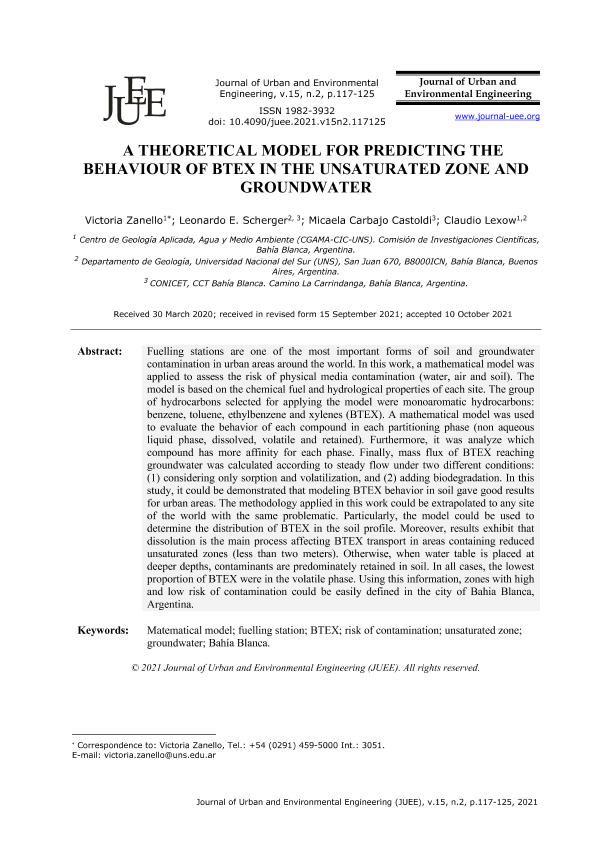Mostrar el registro sencillo del ítem
dc.contributor.author
Zanello, Victoria

dc.contributor.author
Scherger, Leonardo Ezequiel

dc.contributor.author
Carbajo Castoldi, Micaela
dc.contributor.author
Lexow, Claudio

dc.date.available
2022-02-10T17:02:54Z
dc.date.issued
2021-12
dc.identifier.citation
Zanello, Victoria; Scherger, Leonardo Ezequiel; Carbajo Castoldi, Micaela; Lexow, Claudio; A theoretical model for predicting the behaviour of btex in the unsaturated zone and groundwater; Universidade Federal da Paraiba; Journal of Urban and Environmental Engineering; 15; 2; 12-2021; 117-125
dc.identifier.uri
http://hdl.handle.net/11336/151782
dc.description.abstract
Fuelling stations are one of the most important forms of soil and groundwater contamination in urban areas around the world. In this work, a mathematical model was applied to assess the risk of physical media contamination (water, air and soil). The model is based on the chemical fuel and hydrological properties of each site. The group of hydrocarbons selected for applying the model were monoaromatic hydrocarbons: benzene, toluene, ethylbenzene and xylenes (BTEX). A mathematical model was used to evaluate the behavior of each compound in each partitioning phase (non aqueous liquid phase, dissolved, volatile and retained). Furthermore, it was analyze which compound has more affinity for each phase. Finally, mass flux of BTEX reaching groundwater was calculated according to steady flow under two different conditions: (1) considering only sorption and volatilization, and (2) adding biodegradation. In this study, it could be demonstrated that modeling BTEX behavior in soil gave good results for urban areas. The methodology applied in this work could be extrapolated to any site of the world with the same problematic. Particularly, the model could be used to determine the distribution of BTEX in the soil profile. Moreover, results exhibit that dissolution is the main process affecting BTEX transport in areas containing reduced unsaturated zones (less than two meters). Otherwise, when water table is placed at deeper depths, contaminants are predominately retained in soil. In all cases, the lowest proportion of BTEX were in the volatile phase. Using this information, zones with high and low risk of contamination could be easily defined in the city of Bahia Blanca, Argentina.
dc.format
application/pdf
dc.language.iso
eng
dc.publisher
Universidade Federal da Paraiba
dc.rights
info:eu-repo/semantics/openAccess
dc.rights.uri
https://creativecommons.org/licenses/by-nc-sa/2.5/ar/
dc.subject
MATHEMATICAL MODEL
dc.subject
FUELLING STATION
dc.subject
BTEX
dc.subject
RISK OF CONTAMINATION
dc.subject.classification
Ciencias Medioambientales

dc.subject.classification
Ciencias de la Tierra y relacionadas con el Medio Ambiente

dc.subject.classification
CIENCIAS NATURALES Y EXACTAS

dc.title
A theoretical model for predicting the behaviour of btex in the unsaturated zone and groundwater
dc.type
info:eu-repo/semantics/article
dc.type
info:ar-repo/semantics/artículo
dc.type
info:eu-repo/semantics/publishedVersion
dc.date.updated
2022-02-10T12:24:24Z
dc.identifier.eissn
1982-3932
dc.journal.volume
15
dc.journal.number
2
dc.journal.pagination
117-125
dc.journal.pais
Brasil

dc.journal.ciudad
Paraiba
dc.description.fil
Fil: Zanello, Victoria. Consejo Nacional de Investigaciones Científicas y Técnicas. Centro Científico Tecnológico Conicet - Bahía Blanca; Argentina. Comisión de Investigaciones Científicas de la Provincia de Buenos Aires. Centro de Geología Aplicada, Agua y Medio Ambiente; Argentina
dc.description.fil
Fil: Scherger, Leonardo Ezequiel. Consejo Nacional de Investigaciones Científicas y Técnicas. Centro Científico Tecnológico Conicet - Bahía Blanca; Argentina. Universidad Nacional del Sur. Departamento de Geología; Argentina
dc.description.fil
Fil: Carbajo Castoldi, Micaela. Consejo Nacional de Investigaciones Científicas y Técnicas. Centro Científico Tecnológico Conicet - Bahía Blanca; Argentina
dc.description.fil
Fil: Lexow, Claudio. Universidad Nacional del Sur. Departamento de Geología; Argentina. Comisión de Investigaciones Científicas de la Provincia de Buenos Aires. Centro de Geología Aplicada, Agua y Medio Ambiente; Argentina
dc.journal.title
Journal of Urban and Environmental Engineering
dc.relation.alternativeid
info:eu-repo/semantics/altIdentifier/url/https://periodicos.ufpb.br/index.php/juee/article/view/51536/
dc.relation.alternativeid
info:eu-repo/semantics/altIdentifier/doi/http://dx.doi.org/10.4090/juee.2021.v15n2.117125
Archivos asociados
